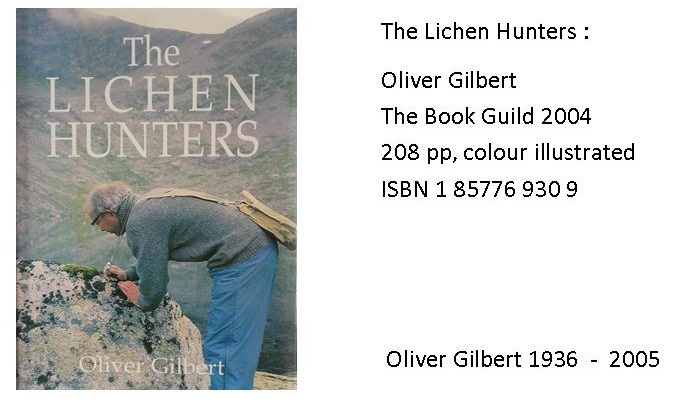I recently had the opportunity of reading and enjoying Oliver Gilbert’s book ‘The Lichen Hunters’. Published in 2004 it is no longer in print, so unfortunately now only available second-hand. There have of course been many reviews of the book over the past twenty years by organisations such as the BLS, the New Scientist and others. (I even found a note in ‘Australian lichenology’). Here are some of my own views which I will attempt to share with you.
The book chronicles the history of lichenology in Britain , concentrating on early enthusiasts and field-work which really got going in the mid nineteen fifties.
After first flicking through the pages I set out to read about the early pioneers as they sought to develop the subject through meetings, excursions and friendly academic cooperation. Memories came back reminding me of areas that I had visited, and people that I had met, during some forty years of working in nature conservation and a lifetime of family holidays. My own very limited experience was soon put into perspective!
In addition to the quite detailed descriptive lichenology, I was impressed by the boundless enthusiasm of those taking forward, what was a relatively specialist subject, towards wider appreciation and enjoyment of lichens by the general amateur naturalist.
I have on my bookshelf quite a few lichen books. Like many before me, I began my interest years ago with ‘The Observers Book of Lichens’ (1963) and ‘The Oxford Book of Flowerless Plants’ (1966), before moving on to Ursula Duncan’s ‘Introduction to British Lichens’, and others. Stimulating and useful as I found these, they are textbooks, aimed at helping with species identification, and providing guidance on habitat preference and distribution. ‘The Lichen Hunters’ is different, it is a readable story, which once started I was reluctant to put down as I moved from one adventure to the next, learning as I went along just what can be discovered by those with energy, persistence and adequate expertise.
That is not to say that I didn’t find some bits difficult . Understandably there is a plethora of scientific names throughout the text (it wouldn’t be half as interesting or as useful if these weren’t there), not surprisingly there are many species new to the U.K. or particular area of search. I found this frustrating at times. Out of a total of some 520 species referred to in the text (yes ! I counted them!) many are not included in Dobson’s Illustrated Guide, which I had by my side looking for illustrations as I went along.
The amount of ground covered is vast, the Lizard to North Rona, County Kerry to the Norfolk coast, St Kilda to the Flannan Isles. Abandoned airfields in Yorkshire and Devon, Churchyards and ancient monuments, crags, boulders, lakes, streams, foreshores and reefs, at times it is exhausting, but, always the feeling of being there. Aching legs, wind in your face, numb fingers and the taste of salt on your lips.
But lichens and where they are found is only part of the story. The book’s title ‘The Lichen Hunters’ indicates that the book is also about people, the folk that went out looking for and recording lichens. Over the years Oliver tells of working with many enthusiasts, professional and amateur, young and old, expert and beginner. A glance at the index at the back of the book reveals just how many names now familiar to us have played a part in driving the subject on (over a hundred). I will not attempt to list them. Many are still with us and active, others have sadly passed on. Who will forget Peter James or Francis Rose? And who will not be excited at the thought of meeting Brian Coppins or Allan Pentecost in the field?
To sum up I can do no better than to present a couple of quotes from the book which I think give an idea of its style, its scope and opportunities for entering a very special world.
The first quote refers to an early BLS meeting on the Lizard Peninsula in 1980 :
`After lunch, taken sitting in the sun, for relaxation we went to the Iron Age Hillfort (at Kynance) to see the stones covered in Teloschistes, Physcia tribacioides and Parmelia tinctina We gradually botanised our way back to the cars, saturated with new experiences, feeling bemused but exhausted, dimly aware that we had experienced one of the great days of British lichenology.`
The second refers to a more recent visit to Borrowdale:
`A visit to the Lake District in May is to be savoured. In the upper valleys the fields are full of Herdwick lambs, the Hawthorns are laden with blossom, there is usually a Cuckoo calling and the sun carries real warmth. The exciting thing about this Lobarion (on pollarded Ash) is its richness, it is the finest in England outside Cornwall, and there is nothing approaching it in Southern Scotland. To me the Lobarion stands for a lost England of Edwardian summers, village cricket, real ale and honey for tea.`
If you get the chance to read it I hope you will enjoy it as much as I did.
Russell Gomm
Oliver Gilbert The Book Guild 2004 208 pp, colour illustrated ISBN 1 85776 930 9
Oliver Gilbert 1936 – 2005
